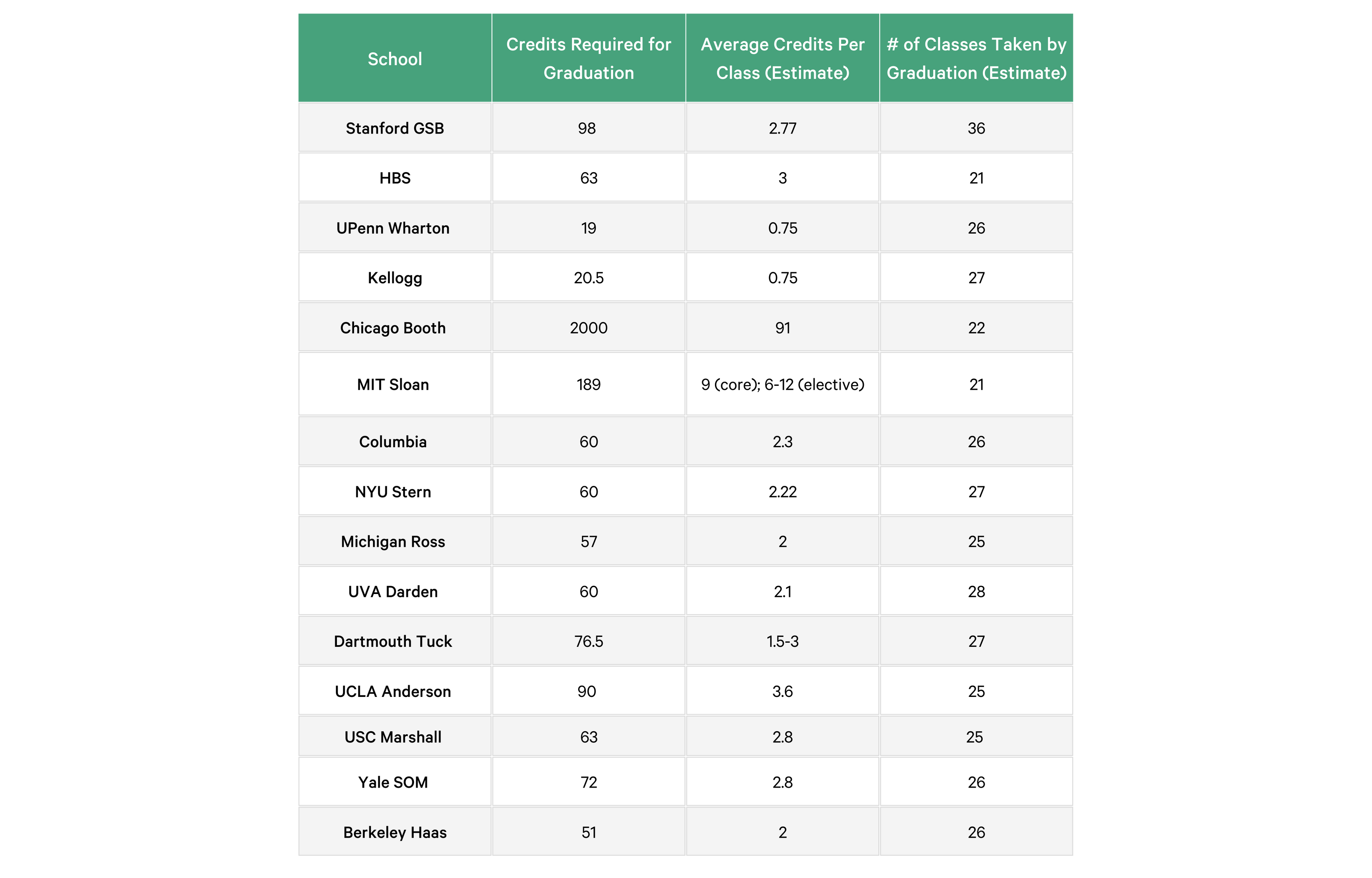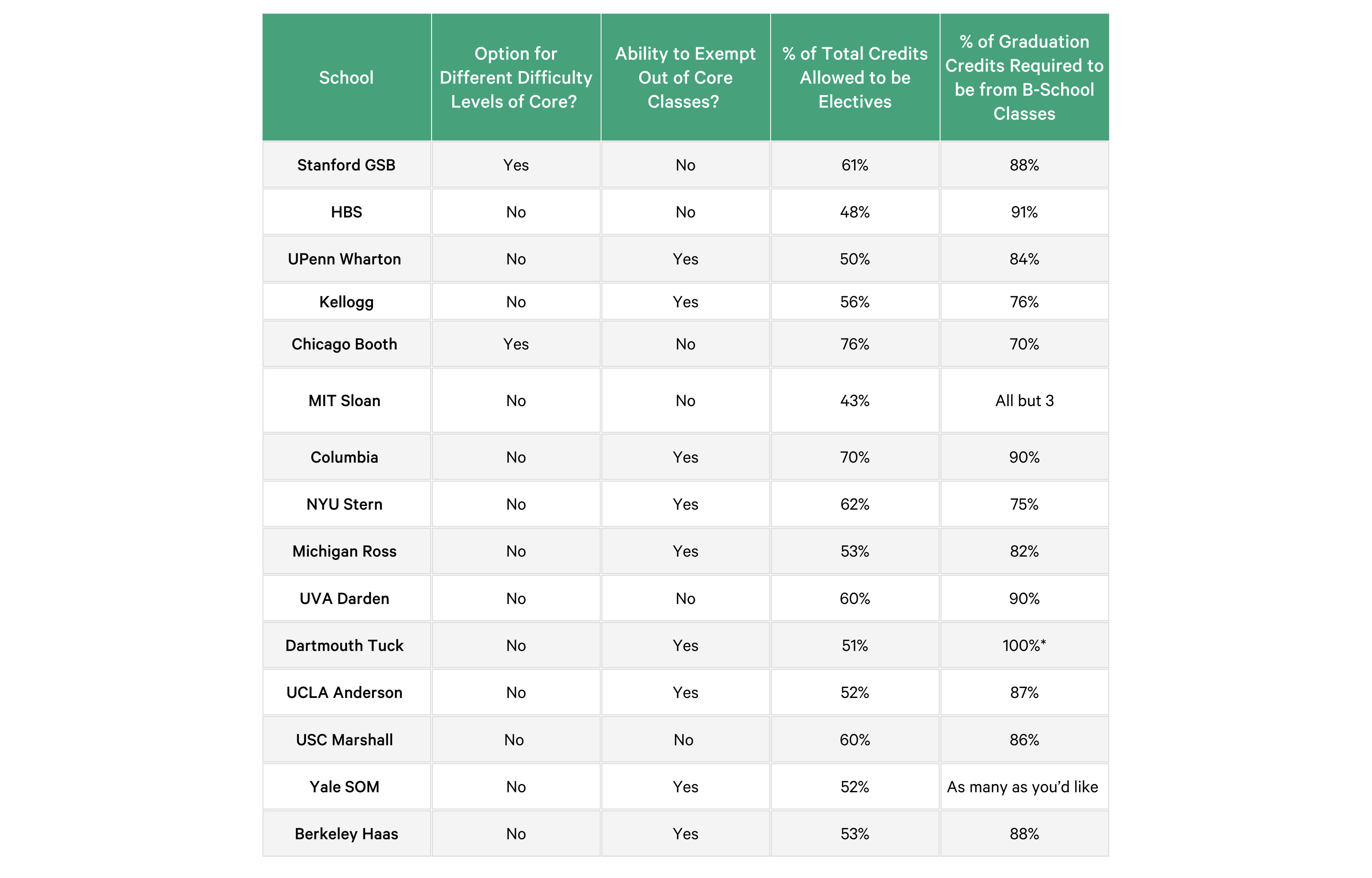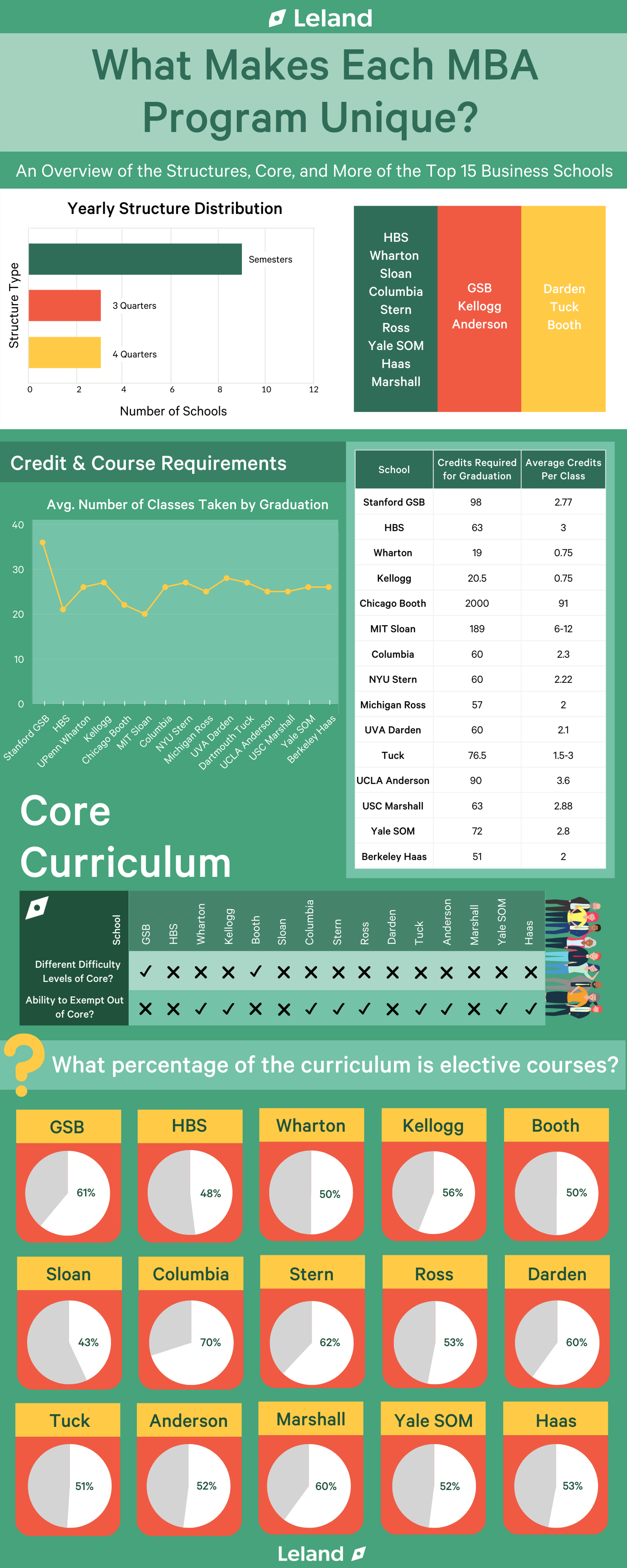Not Every MBA Program is Made Equal–An Overview of the Program Structures of Top Business Schools
The program structures of the top 15 business schools, including the number of credits and courses required for graduation, the percentage of electives vs. core classes, the proportion of required classes, and more.
Posted June 18, 2025

Join a free event
Learn from top coaches and industry experts in live, interactive sessions you can join for free.
Table of Contents
A Master of Business Administration (MBA) degree is one of the most popular advanced degrees. It’s commonly understood to be a general management degree, but what does that actually mean? Students decide to get an MBA for many different reasons and use their degrees in a wide variety of ways. If you were to look at my Stanford transcript, you would find one path to an MBA, but no one in my class at the GSB had the same path.
The specificities of business school programs have a largely unrecognized effect on the skills and knowledge attained. Sure, every school has a kind of “core curriculum,” but even that varies dramatically. For example, the core classes at Stanford have different levels that MBA candidates can choose from, including base, accelerated, and advanced. Then, there are the core classes that exist within certain disciplines, but with a library of options from which to choose. Finally, there are the electives that compose the gross majority of the program and are generally free range. Some schools even allow electives for more than 75% of all required credits, and we haven’t even discussed the courses that many candidates choose to take outside of the business school.
There is an unspoken understanding that many people who go to business school do so for career and networking opportunities, but you still end up spending a lot of time in class! For this reason, it’s important to understand how these different business schools structure their MBA programs. While some schools require lockstep classes, others allow for substantial variability. Some programs run on a semester system, and others on quarters. Some programs only necessitate 21 classes for graduation, whereas others require 36!
This variation heavily affects the business school experience, and yet it’s hardly known or acknowledged from the outside. I’ve done the research on what each of the 15 top schools actually requires for graduation, so you can see how different they really are, and choose the one that’s the best fit for you.
Yearly Structure
Business schools structure their programs in one of three ways: by semester, three quarters, or four quarters. Many of them, regardless of the structure, also offer “mini-terms” where students can take an accelerated version of a limited number of classes. For example, there is a Fall A and B at Michigan Ross and a J-Term (or January term) at HBS.
Here is an overview of which schools prescribe to which structure:
Semesters: HBS, Wharton, Sloan, Columbia, Stern, Ross, Yale SOM, Haas, USC Marshall
3 Quarters: Stanford GSB, Kellogg, UCLA Anderson
4 Quarters: Booth, UVA Darden, Dartmouth Tuck (3 in second year)
Credit/Course Requirements
The number of classes that students are allowed to take will affect the number of subjects that they’re exposed to. Those who want a broader exposure to a lot of different topics may benefit from more classes offered, but others may feel overwhelmed by all of the options and variety.
Also, it’s good to have an idea of what your tuition covers and doesn’t cover. Typically, credits above the minimum required for graduation are allowed up to a certain extent. For example, students at Haas can take 16 credits per semester, even though only 12-14 are required for the degree. At GSB, 16-17 credits are required each quarter for graduation, but students can take up to 22 for no additional charge. NYU Stern, on the other hand, charges for every class taken above the 60-unit requirement, except for one free class.
Some universities are very strict with how many classes their MBA students can take during their time enrolled. Stanford only requires 98 for graduation, but allows 132 for the same price. NYU, however, requires 60 credits but only allows 63. For those hoping to take more than what’s required, this is an important factor to know.

Insights
Stanford GSB requires many more classes than all of the other MBA programs. While this may mean exposure to more subjects, it does not measure time-in-classroom. Most of the other schools end up with a similar number of courses taken by graduation, with the exception of Marshall, Sloan, Booth, and HBS, who are on the lower side at 20-22 classes. Many schools will have varying levels of credits per class; for example, classes at MIT Sloan vary from 3 to 12 credits each, depending on the time in class.
Core Courses and Electives
Knowing the number and type of core courses that you’ll be required to take can affect your decision, especially if you are on the higher or lower side on the scale of experience. Those with a more traditional business background may prefer fewer required core courses and more flexibility built into the program, as they will have likely encountered much of the content already. The specific core classes that each program requires are listed at the bottom of this article.
Many business schools are at world-class universities with strong programs in other disciplines. Most schools offer credit for non-business classes, but restrictions vary quite drastically. For applicants interested in interdisciplinary subjects who don’t want the time commitment that comes with a joint or dual-degree program, having an idea of what percentage of classes can be taken outside of the business school is beneficial. Booth and Stern are among the most generous in this regard, while Columbia and HBS are the least.

*Students who want to take classes at other Dartmouth colleges can petition for those credits to count toward graduation.
Insights
The percentage of elective vs. core credits required only tells one-half of the story. The other important factor to look at is the option for flexibility within the core curriculum. For example, Booth offers a very flexible core curriculum in that there are general subjects that are required from which students have the option to choose what classes they’d like to take. For the “Microeconomics” requirement, MBA candidates can take Microeconomics, Accelerated Microeconomics, or Advanced Microeconomic Analysis (Basic Courses) or Price Theory I or Price Theory II (Advanced Courses). Several schools take this approach with mandated core subjects and flexible choices within those subjects.
The school with the most electives offered is Columbia, by a fairly large margin, at more than 300. HBS offers around 100, GSB 130, and Wharton 200.
It’s also important to note, especially for those coming from a business background with several years of work experience, that most schools let their students choose the difficulty levels of core classes, or get an exemption through tests or prior certifications. The schools that don’t let you do this are typically the case-heavy ones like Harvard and the University of Virginia.
So What?
For many people applying to business school, the strategy is to apply to all of the top programs and attend the best one that they get into. This is not a bad strategy, given so much of the perceived business-school value comes from the prestige and reputation of the school you attend. However, the “best” school is not always the one that will most benefit you.
Every top MBA program will provide you with networking and career opportunities, but the one that will teach you the most, give you the greatest space to grow, and contribute most to your personal and professional development may not be the program that is ranked the highest that year.
For some, the academic rigor or course offerings are not as important as the post-graduation employment statistics or class profile. Others may care strictly about the brand of the school. What matters to each will depend heavily on the individual. Having an idea of the intricacies of each program’s structure can provide help on one piece of the puzzle, but the entire image will be unique and specific to you. As you apply to business schools and weigh your options, consider both the details of each program as well as the high-level differences. Find what is most important to you, and prioritize those aspects.
Here are some questions to reflect upon when choosing which school is right for you:
- Which learning style do I feel is best for me? For example, HBS uses the case method for the entire curriculum. Is this classroom style actually an environment in which I would thrive?
- Do I want to have a major/emphasis and lean into a specific category within business? If so, look at programs that offer tracks in your areas of interest.
- Are there specific classes at a particular university that excite me? For example, GSB is known for the hands-on, project-based course called “Startup Garage.” If I am looking to go into entrepreneurship, I may focus on applying to business schools that have a strong commitment to startup resources and coursework.
- Do I value autonomy in deciding what my course load consists of? How much flexibility do I want in my curriculum?
- Am I interested in taking non-business classes during my MBA years? If yes, I should find a program that allows for this.
The list goes on, but you get the point. Not every MBA program is the same, and this is for the best. What makes each school and experience unique is that different people will be able to find an environment in which they will thrive and find the value they’re looking for. Be deliberate about researching, exploring, visiting, and talking with people at the schools you are interested in. Be honest with yourself and you will get what you are looking for out of the process.
Where Can I Start?
To get personalized advice and guidance on any part of the MBA application process, book a free intro call on my profile. As a coach, I’m all about making the application process fun, exploratory, and insightful, and I’d love to support you through your journey.
Here are some other articles you might find helpful:
- The Different Types of MBA Programs—and Which One is Right for You
- The Truth About Business School Rankings - and What It Means for You
- Part-Time MBA vs. Full-Time MBA Programs
- The Complete MBA Application Guide
- What Do You Actually Learn in Business School?
Leland provides you with the content, community, and coaching that you need to get into your dream MBA program and accomplish other ambitious goals. Sign up today to gain access to additional free resources, community events, small group classes, world-class coaching, and more.
For the more visual learners out there, we’ve put together an infographic with some of the information from this article. Use it as you compare, contrast, and decide which MBA program is the best one for you.

FAQs
What is the difference between an MBA and a non-MBA?
- While an MBA can lead to higher earnings in the short term, it's important to consider long-term career prospects as well. Individuals with an MBA may be more likely to advance into higher-level positions, which can lead to long-term financial stability.
Are there different MBA programs?
- Specialized MBA Programs - Whether focusing on healthcare, finance, marketing, entrepreneurship, or supply chain management, these programs equip students with specialized skills and knowledge tailored to meet the demands of their target industries
What is the top MBA school?
- Northwestern University (Kellogg)
- Stanford University.
- University of Chicago (Booth)
- Massachusetts Institute of Technology (Sloan)
- Dartmouth College (Tuck)
- Harvard University.
- New York University (Stern)
- Columbia University.
What is the MBA program?
- In the most straightforward sense of the definition, MBA stands for Master of Business Administration. Like many graduate-level degrees, an MBA is associated with professionalism, hard work, and specialization. These programs typically include classes focusing on: Organizational psychology and behavior. Finance.
Is every MBA the same?
- Every top MBA program will provide you with networking and career opportunities, but the one that will teach you the most, give you the greatest space to grow, and contribute most to your personal and professional development may not be the program that is ranked the highest that year.
Browse hundreds of expert coaches
Leland coaches have helped thousands of people achieve their goals. A dedicated mentor can make all the difference.


























